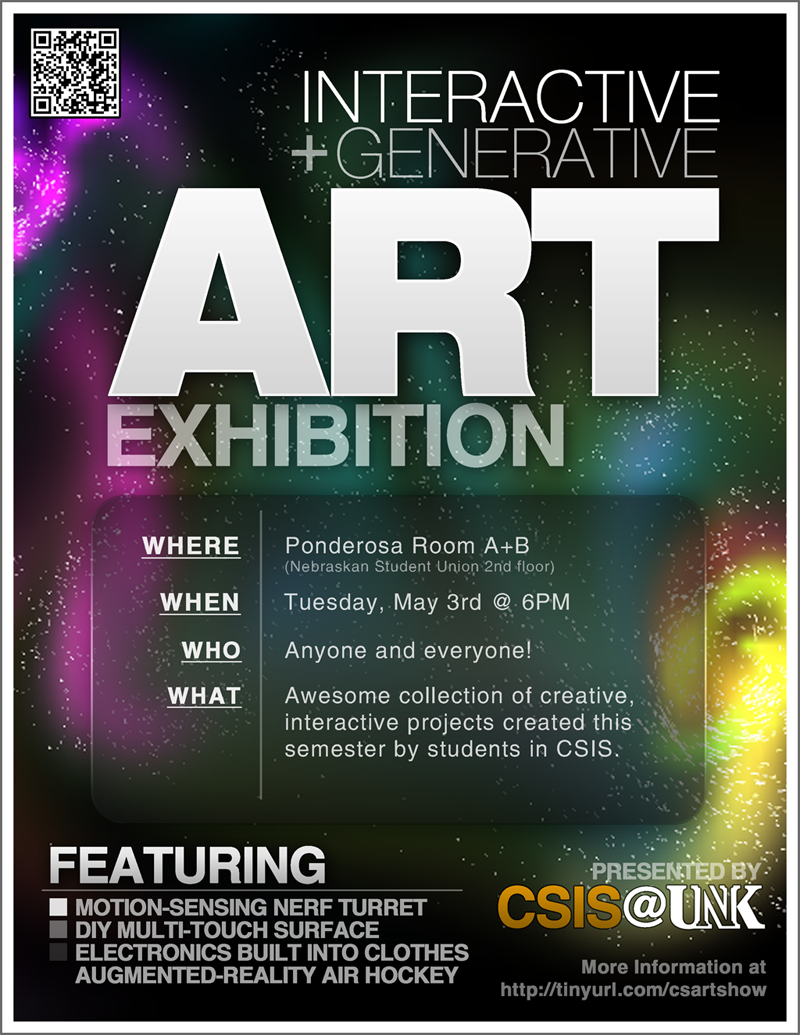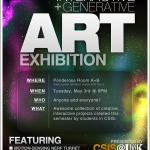
2011 Interactive and Generative Art Exhibition
In order to celebrate and display the works of 10 students from my Interactive and Generative Art course from Spring 2011, I organized the Interactive and Generative Art Exhibition, free public show open to anyone in the Kearney community. It showcased a variety of diverse projects, all completed by students, including a motion-sensing NERF turret, a force-feedback vest for XBox controllers, several e-textiles projects and more.
About the Interactive and Generative Art class
In the fall of 2010 I generated curriculum to introduce undergraduate Computer Science students to the basics of physical computing, creative coding and new media practices, with the hopes of seeing it become a real class in the future. Fortunately, the Computer Science Department was able to offer an independent study course in the Spring 2011 semester using the curriculum, which I was then asked to teach personally.
Students participated in a variety of workshops and hands-on labs and were ultimately asked to execute a unique final project to be exhibited to the public. Therefore, this exhibition was a collection of all of these students projects, as well as a demonstration of the interest that students have in learning about these new technologies.
Exhibition proceedings
 Before the exhibition began, I designed a flyer to be printed and hung up around campus (and around town) and tried to spread news about the exhibition by word of mouth as much as possible. It was completely unknown to me how well the event would be received, but we set everything up and hoped for the best.
Before the exhibition began, I designed a flyer to be printed and hung up around campus (and around town) and tried to spread news about the exhibition by word of mouth as much as possible. It was completely unknown to me how well the event would be received, but we set everything up and hoped for the best.
Over the course of the evening, we welcomed a steady stream of guests throughout the entire duration of the exhibition. Several of the guests and faculty judges estimated that over a hundred visitors came by over the course of the four hour event! Far from the atmosphere typical to traditional art galleries, the space was full of excited voices, with interesting discussions popping up randomly all across the exhibition space.
Each student was given a table to set up their project and demonstration materials on, and were encouraged to hang out by their table in case guests had questions. Happily, the vast majority of the tables were nearly constantly surrounded by a small crowd and a lively conversation, as guests began to try to understand how the various projects worked. To that end, I was very happy to see that all of the students did a fantastic job of fielding questions and demonstrating their projects in a way I had not seen in other exhibitions. Because students were free to demonstrate and explain their projects one-on-one, with no faculty overhead, they were clearly enjoying themselves in a way that wouldn’t be possible if they were dressed up in business attire and tending to a single poster on a wall.
Student interviews
As part of their final project grade, each student was expected to give a short (less than 2 minute) interview / demonstration of their project, with the intent of sharing these videos to the maker community. Each of the students’ interviews are available below, along with links to their websites where you can learn more about their project.
Jennifer Dieckhoff
Night Light Pillow using E-Textiles
Using the Lilypad Arduino platform and some simple electronics, Jen literally stitched together her project using conductive thread and fabric! Her idea was to create an insertable pillow case with LEDs embedded into it in order to create a comforting night light pillow for young children, whereby the pillow softly glows and twinkles while they fall asleep, turning itself off automatically after a set amount of time. Though she was only in her first semester of Computer Science at the time, Jen created one of the most technically challenging and aesthetically interesting projects in the show, earning her the Best in Show award from the guest judges!
Josh Wilson
Immersive gaming vest for Xbox 360
Being a gamer himself, Josh wondered how hard it would be to create an immersive gaming vest that responds to action going on in-game. He embedded a few DC motors into a cheap vest and wired them up to an Arduino, which was also wired up directly to the vibration motors inside an XBox controller! By analyzing the electrical signals going through the controller’s motors, he was able to actuate the motors in his vest accordingly, creating a more immersive experience for the player.
Tyler McConville
Multi-touch color mixing application
Tyler knew he wanted to create a program for the multi-touch surface I was building for the CSIS department, but he had to get it working first! Before coding his app, he spent a good amount of time with fellow student Adam Zheng to calibrate the lasers for the surface and get it all up and running. Once things were functional, he built a color mixing application using Processing that allows users to position semi-transparent circles of color on the screen and try to mix them together like one might with paper or paint.
Adam Zheng
Secret Knock-Detecting Box
Drawing inspiration from a cool project found on Instructables, Adam custom-built a wooden box with a servo-actuated trap door that responds to patterns that are tapped onto the box. Because all of the electronics are securely hidden inside the box, treasures could hypothetically be stored in his box without the need for a traditional lock or keypad!
Ryan Levell
Light-reactive robot from hacked RC car
Ryan got his hands on a cheap RC car and turned it into a little robotic platform. He removed all of the radio control circuitry and replaced it with an Arduino, some light sensors and a motor driver. Using code, he could easily make the robot chase or avoid light or shadows, making it behave almost like a little insect with wheels.
Scott Tallmage
Motion-sensing NERF turret
While this class was going on, a popular game in the dorms of UNK was all-out NERF battles. Hoping to gain an upper-hand on the battlefield, Scott decided to take his NERF Vulcan gun and try to convert it into an autonomous turret to destroy his competition. Eventually, he was able to remotely activate the firing mechanism of the gun using a transistor, then wire up an ultrasonic distance sensor to make the gun fire anytime a target passes its line of sight. His project definitely turned out to be one of the biggest crowd-pleasers of the exhibition, firing soft bullets at nearly every person who came through the doors!
Tyler Adelung
Alien Invaders game using Processing
While he was enrolled in this class, Tyler was also enrolled in Artificial Intelligence, so he thought it’d be interesting to try to cross-pollinate the two areas and create a game that uses real AI algorithms in it. Though you may not be able to tell from the short video below, he used some really cool AI techniques to make the enemy choose targets to fire upon in real-time! Tyler did a really fantastic job documenting and explaining his project, so be sure to check out his project site for more information and source code!
Patrick Mooney
Alternative power system controls using PowerSwitch Tails
After reading about the cool PowerSwitch Tail outlet control device, Pat thought it would be fun to experiment with using them to control various AC devices with non-traditional inputs. Pat wired up a series of arcade buttons to an Arduino, which were then connected to individual PowerSwitch Tails controlling thrift-store lamps. Passer-bys were invited to hang out and play with the lights and think about what they could do with the PowerSwitch tails at home – control coffee makers using joysticks, flip on and off blenders with music and so on.
Garrett Kearney
xAnimate – Generative animation program
Already a seasoned programmer, Garrett had a more advanced project in mind for his final project – a 3D kinematics system for video games. Unfortunately, the documentation for this project has already been lost, and no video interview was conducted during the exhibition. I suppose this will just have to be a lesson to me to be more vigilant in gathering information and managing students in the future!